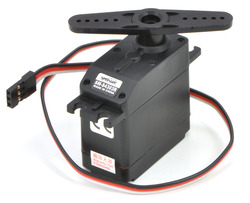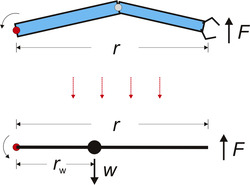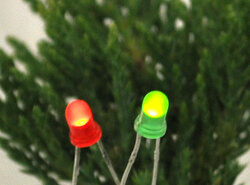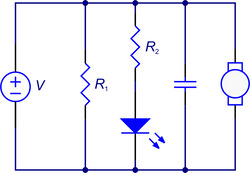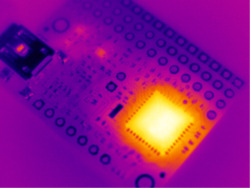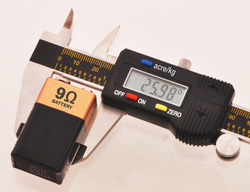Pololu Blog » User Profile: Jan » Posts by Jan »
Posts by Jan (Page 10)
You are currently viewing a selection of posts from the Pololu Blog. You can also view all the posts.
Popular tags: community projects new products raspberry pi arduino more…
Introduction to servos
Hobby servos are small, modular actuators developed by the radio control (RC) hobby industry for remote manipulation of everything from miniature boat rudders and car steering linkages to model airplane flaps and toy parachutist release mechanisms. The RC market is large and competitive, which has led to a proliferation of servos that have been optimized for characteristics including size, speed, torque, and price. This modularity, variety, ubiquity and cost-effectiveness of servos make them attractive generic actuators for small robots and other electromechanical systems. Continued…
Introduction to an introduction to servos
My last post about force and torque got kind of long, prompting some suggestions that I break it up into two separate posts. I didn’t do it because my sentiments about units and the common confusion of weight and mass applied to both topics. I want to move on to a thorough discussion of hobby servos, which is broad enough of a topic that it definitely merits a breakdown into multiple posts. That got me thinking about the order in which to present the material. So, this post is mostly about organizing and presenting information and not really about servos. Continued…
Force and torque
I got a few private requests for more information about torque after my post on units, and since torque is relevant to the next few posts I want to make about servos, I’ll try to explain torque a bit more today. Torque is intimately connected to force, so we’ll start with a review of Newton’s laws of motion. You should know some basic calculus to really understand these concepts, but getting into that is beyond the scope of this post; I hope I hit the right level of simplification to provide some useful knowledge to those who have some basic intuitive mechanical sense but have not taken, or have forgotten, basic physics courses. Continued…
More LEDs
With Christmas just a few days away, and having just discussed a single LED circuit and simple parallel circuits, I’d like to make a few comments about using multiple LEDs. I’m still talking about basic LEDs, and not too many of them; for specialized LEDs or large arrays, there are all kinds of chips designed just for that. Continued…
Parallel circuits
If you have a limited or informal electronics education, parallel circuits might be the kind of topic you glossed over or have forgotten about. After all, parallel circuits sounds like boring theory, and you want to get to the fun stuff. But, banging your head over a simple system that you think should just work isn’t much fun, and you can save yourself a lot of grief with a bit of awareness about the potential differences between a schematic and a physical circuit. Also, I’m a proponent of learning fundamentals and trying to really understand things, so we’ll start with a bit of the basic theory. Continued…
Simple LED circuit abstractions
The simple LED circuit from last time is a great first circuit for everyone interested in electronics because it is so forgiving. If you connect something backwards, you probably won’t break anything, and otherwise, it should just work. However, that forgiving nature of the circuit can beguile newcomers into thinking everything is that simple, and though there are many web pages out there discussing the circuit, they usually do not address the abstractions and simplifications that are in play and why we can use them in this instance. So, that’s the topic for this post. Continued…
Simple LED circuit
One of the simplest circuits you can build is an LED powered by a battery. Unfortunately, many people who think they know some electronics (and even multiple job interviewees with supposed electrical engineering degrees) cannot actually draw the schematic for the simple circuit or calculate the appropriate component values. Can you? Continued…
Abstractions
We should consider the general concept of abstraction in robotics a bit before moving on to more specific topics. Abstraction comes up a lot in computer science and programming, so I think people in that field are exposed to it early and often. Just about any program will have at least some user-made abstractions in it, be it a data structure or a subroutine, so programmers tend to be aware that the abstractions are just whatever they choose to make them and that they are not necessarily statements of absolute fact. In other introductory engineering contexts, at least in my experience, there is less of an explicit acknowledgment of the abstractions being used. Continued…
What's in a name?
At the risk of sounding like I’m telling you to eat your vegetables, I’m going to zoom out one more step from the last post about units and talk even more generally about the importance of names. Whatever you think of Juliet’s famous answer, the reality is that if you want to get someone a rose, or even just to talk about a rose, you need to know what it’s called. Naming things is a very powerful human skill that allows us not only to better communicate our thoughts but to better form our thoughts in the first place. Continued…
Know your units
How many volts of current are there in a bolt of lightning? That’s the kind of stupid question your local news anchor might ask while bantering with the weather guy. Perhaps your favorite cringe-inducing unit abuse is someone thinking light-years measure time or a model rocket enthusiast telling you that a newton-second is a little longer than a regular second. Of course, I made the same class of mistake when looking for a 1-amp battery, which I described in my previous post about battery capacity. That article addressed a specific instance of a general problem: not knowing or understanding units, which allow us to talk about and measure physical properties that we must understand whether we’re designing robots or baking cakes. Continued…
